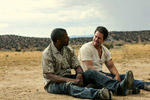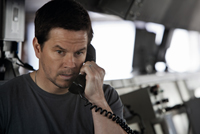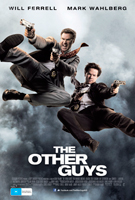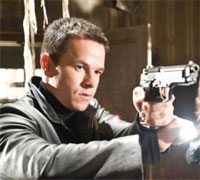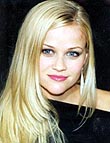Mark Wahlberg Deepwater Horizon
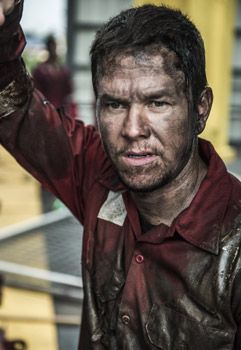
Mark Wahlberg Deepwater Horizon
Cast: Dylan O'Brien, Kate Hudson, John Malkovich, Mark Wahlberg, Gina Rodriguez
Director: Peter Berg
Genre: Action, Drama
Synopsis:On April 20th, 2010, one of the world's largest man-made disasters occurred on the Deepwater Horizon in the Gulf of Mexico. Directed by Peter Berg (Lone Survivor), this story honors the brave men and women whose heroism would save many on board, and change everyone's lives forever.
Summit Entertainment and Participant Media present a di Bonaventura Pictures production, a Closest to the Hole / Leverage Entertainment production, a Peter Berg film.
Deepwater Horizon
Release Date: October 6th, 2016
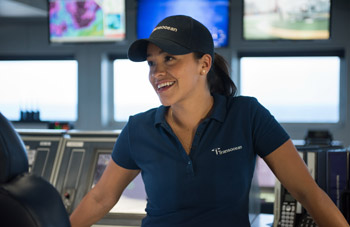 About The Production
About The Production
On April 20th, 2010, one of the world's largest man-made disasters occurred on the Deepwater Horizon in the Gulf of Mexico. Our film follows a vital story that many have not seen: the story of the 126 crew members working aboard the Deepwater Horizon that day, caught in the most harrowing circumstances imaginable. They were skilled working men and women putting in a gruelling shift in the hopes of getting back soon to families and lives ashore. In an instant, they were faced with their darkest hour, pushed to summon the courage to battle an unstoppable inferno blaze in the middle of the ocean, and when all seemed lost, to save one another.
The ultra deep-water drilling rig off the Louisiana coast – the Deepwater Horizon – riveted the world as it experienced a devastating blowout, fire and nearly unstoppable ocean floor oil leak. For 87 days millions watched, hearts in mouths, as more than 50,000 barrels of oil a day gushed from the sea floor into the Gulf of Mexico. It would become the largest accidental ocean oil spill in human history. The impact to marine life and the questions of what went wrong and why are ongoing.
Deepwater Horizon brings that story to the screen with a gripping glimpse into the unseen world behind the global disaster that took the lives of 11 workers. Filmmaker Peter Berg once again collaborates with Oscar® nominated actor Mark Wahlberg sharing an untold story of men & women, real life heroes, who faced extraordinary consequences with extreme bravery. The pair previously explored a Navy SEAL team mission gone wrong in the Oscar® - nominated Lone Survivor, and the duo is currently filming Patriot's Day, the story inside the dramatic events leading up to and after the Boston Marathon bombing. In Deepwater Horizon, Mark Wahlberg is joined by an incredible cast including Kurt Russell, John Malkovich, Gina Rodriguez, Dylan O'Brien and Kate Hudson to bring audiences directly into, not only the events, but the charged human drama and acts of valor beneath them.
Mark Wahlberg takes on the role of real-life Transocean chief electronics technician Mike Williams, a devoted family man who was overseeing the rig's computers and electrical systems on April 20th, when everything he imagined could go wrong … did. Oil rig workers are a notoriously tough and gritty breed. The work is physically punishing and ultra high-pressure – as workers grapple with complex equipment approximately 60-feet above remote seas. Yet even for Williams, what happened that day was unprecedented. Williams knew the work was desperately behind schedule, but he also knew the Deepwater Horizon had sophisticated defenses said to be able to prevent even the worst blowouts.
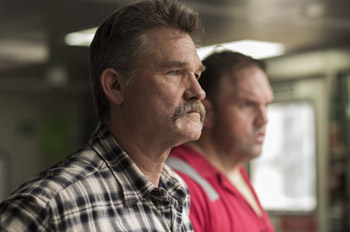 Nevertheless at 10 p.m. that night, volatile methane shot up into the rig, and all the rig's defenses failed. The result was a sudden, deadly explosion and a series of fireballs, as the shattered rig and its crew were shaken, hurtled and drenched in combustible gas.
Nevertheless at 10 p.m. that night, volatile methane shot up into the rig, and all the rig's defenses failed. The result was a sudden, deadly explosion and a series of fireballs, as the shattered rig and its crew were shaken, hurtled and drenched in combustible gas. From that moment on, Williams was in a race to save his own life and those of his crewmates – each driven by the hope of making it home -- in an escape that seemed to defy all the odds.
For Berg, the story's themes were vivid stirring and a chance to shed light on an event most often talked about in terms of the environmental, rather than human, impact. 'I'm drawn to tales of human courage and of the human spirit trying to triumph over real adversity - and those elements are the heart of this story," says Peter Berg. 'The men and women aboard the Deepwater Horizon were extremely intelligent and capable and they tried everything they could to prevent the blowout. It's important to remember that 11 people lost their lives on the rig, and more were injured. In the middle of all the deserved attention for the oil spill, that heroism has almost been lost. This film is a chance to tell that story."
The Screenplay
To dig into the lives and hearts of the men and women for whom the Deepwater Horizon was at once home, workplace and a perilous trap after the blowout would require intensive research. The events were complex, contested at times, and involved highly technical machinery and jargon. All of that became background in the screenplay by Matthew Michael Carnahan and Matthew Sand, and screen story by Matthew Sand, which instead put the life-and-death experiences and in-the-moment emotions of the crewmembers front and center.
The foundation for the screenplay was a seminal New York Times article: 'Deepwater Horizon's Final Hours," written by David Barstow, David Rohde and Stephanie Saul, which was in turn the result of probing interviews with 21 survivors, as well as sworn testimony and written statements from others, creating the most detailed insiders' account of what they saw happening, second-by-second, on the rig. Matthew Michael Carnahan then went further, conducting and distilling his own interviews, focusing in on the emotions, connects and love of life that drive a person to find the heights of skill, bravery and compassion in the midst of disaster. The result became a moving exploration of how ordinary people commit extraordinary acts when it matters most.
Matthew Michael Carnahan says he felt a fierce responsibility to be true to what the men and women on the Deepwater Horizon went through, especially those who did not make it home. "I tried to do the very best I could to honor the fact that 11 people lost their lives that night. I've never worked on a movie before with that kind of reality," notes the screenwriter. 'The people who lost their lives were always omnipresent in my mind while I was writing."
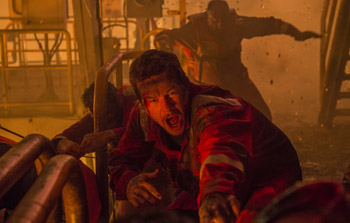 When real-life survivor Mike Williams – whom Mark Wahlberg portrays in the film – came aboard as a consultant it was a litmus test. Williams admits he had his doubts that a movie could do any justice to what he saw and felt that night. He was soon exhilarated by Peter Berg's human-centered approach and interest in immersing audiences in the rarely seen lives of oil rig workers before the blowout ever occurs.
When real-life survivor Mike Williams – whom Mark Wahlberg portrays in the film – came aboard as a consultant it was a litmus test. Williams admits he had his doubts that a movie could do any justice to what he saw and felt that night. He was soon exhilarated by Peter Berg's human-centered approach and interest in immersing audiences in the rarely seen lives of oil rig workers before the blowout ever occurs. 'Once Peter Berg told me -this is a story about survivors,' I agreed to come on board. The oil field is not very well understood by outsiders," Mike Williams points out. 'It's a very close-knit community, so I think this is a great opportunity to show the world what these men and women do out there."
For Peter Berg, giving audiences a look at the human side of the deep-sea oil rigs we all rely on in the contemporary world was essential. Peter Berg summarises: 'We all use fossil fuels and petroleum. Even if we drive a hybrid, we use fossil fuels. Yet we know very little about how we get our fuels. This movie is a chance to bring audiences inside these gigantic rigs that are so technologically amazing, to show the men and women working on them who are so highly skilled and dedicated, and to reveal that even though we never see these men and women, they really are closely connected to our lives."
What Was The Deepwater Horizon?
An insatiable demand for fuel has brought oil companies into ocean depths where humans have never before dared to labor, bolstered by new high-tech equipment capable of plunging thousands of feet below sea level, operating where humans can't go, amid shifting sands and hazardous pockets of explosive gas. It's a brave new world of exploration for the oil industry, but on April 20, 2010, the dangers of that world became devastatingly clear.
On that day, the Deepwater Horizon, an ultra-deep-water, advanced oil rig owned by the Swiss company Transocean and leased by British Petroleum was drilling deep in a well named Macondo about 40 miles off the Louisiana coast. Suddenly, the crew faced the greatest fear of all ocean rig workers: a ferocious blowout, caused by pockets of unstable methane shooting up the pipes with deadly force. Though equipped with a blowout preventer that included an Emergency Disconnect System (EDS), both failed to contain the blowout. The initial blowout killed 11 men who were never found, critically injured others and sparked a bold evacuation of men and women trapped amid roiling mud and fire. After two days of searing flames, the remains of the Deepwater Horizon sank 5000 feet to the ocean floor, leaving the well gushing beyond control, ultimately releasing, according to government estimates, 4.9 million barrels of oil.
Since then, the words Deepwater Horizon have become synonymous with the words 'largest marine oil spill in history." But prior to that, the Deepwater Horizon was seen as a technological marvel. An offshore oil rig is essentially a stationary cruise ship – and the Deepwater Horizon was among the most sophisticated in the fleet. Built in South Korea, the rig featured a deck the size of a football field, a 25-story tall derrick and below-deck living quarters for 146 people, including a gym and movie theater. The mechanical innards of the Deepwater Horizon utilized space-age technology, spanning from electronic drilling monitors to computerized modeling systems and automated shut-off defenses.
But wondrous as the rig was, it was also, at the time of the explosion, 6 weeks behind schedule, and costing a half million dollars a day – pushing management to complete the well as fast as possible. The full consequences of the Deepwater Horizon blowout are still being assessed. After several failed containment attempts, on September 21, 2010, the well was finally declared dead. Today, court cases are ongoing, coastal businesses are recovering and environmentalists are studying damage to marine life. But for the 11 families who lost their loved ones, and the workers who faced mortal danger, the consequences are felt every single day.
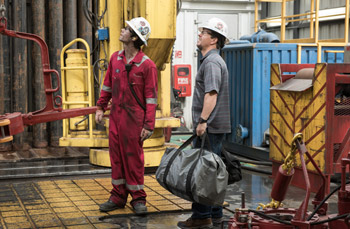 The Cast
The Cast When it came to casting Mike Williams – the Chief Electronics Technician of the Deepwater Horizon at the time disaster struck – the search was on for someone who could penetrate the very particular world of technicians who live and work on oil rigs, as well as a man who taps into unrealized reserves of physical and emotional strength to make it home to his family.
It quickly became clear that few actors were as close a match for that description as two-time Oscar® nominee Mark Wahlberg. In roles ranging from The Fighter to The Departed to Peter Berg's Lone Survivor, Mark Wahlberg has demonstrated a distinctive ability to explore the inner realities of blue-collar men.
Mark Wahlberg and Mike Williams bonded before the film started shooting and spent a lot of time during production on and off set together. The filmmakers were excited by the resulting performance. Says producer Lorenzo di Bonaventura: 'What Mark Wahlberg brings is honesty and a real sense of blue-collar integrity. He brings out that American ethic of doing hard work, even when you're working amid forces you can't necessarily control."
Equally key to the casting was finding the film's 'Mr. Jimmy," Jimmy Harrell, who was the offshore installation manager of the Deepwater Horizon – essentially in charge of the entire crew. Golden Globe® nominee Kurt Russell, another star renowned for his real-guy appeal, stepped into the poignant role. Kurt Russell notes that Jimmy Harrell was deeply respected by the crew and thought of them as family. Kurt Russell also became fascinated by how people react when they have to make impossible decisions under extreme pressure. 'You realize that in this very dangerous world, when things go wrong, human beings can only try to make the right decisions," says Kurt Russell. 'These are not black-and-white kinds of decisions. It's a difficult thing to face."
After the explosion, Mike Williams aligns himself closely with 23 year-old rig worker Andrea Fleytas, who is played in a departure by Golden Globe® winner and 'Jane The Virgin" star Gina Rodriguez. Gina Rodriguez had to explore both a woman's deepest fears and greatest courage for the role. 'The true life Andrea is a real character and Gina Rodriguez brings great energy and an essential goodness to who she is as a person," says di Bonaventura. 'She also captures what it's like to be a 23 year old woman in the middle of a crazy, ultimately catastrophic situation."
Says Gina Rodriguez of embodying Andrea Fleytas: 'Peter Berg was all about trying to be as authentic as possible, so I did a lot of my own research and even went to dynamic positioning officer training in Houston. It was quite the experience."
Also joining the ensemble are two-time Oscar® nominee John Malkovich as BP company man Donald Vidrine; Dylan O'Brien as the young floorhand Caleb Holloway and Oscar® nominee and Golden Globe® winner Kate Hudson, who coincidentally is starring in a film for the first time alongside Kurt Russel. Kate Hudson portrays Mike Williams wife, Felicia. Says kate Hudson: 'What's exciting about this film is that people will not only understand more about what happened on the Deepwater Horizon but also get to know these people and the actual experience of how terrifying and challenging it was."
Life On An Oil Rig
Production of Deepwater Horizon began in the summer of 2015 in New Orleans, Louisiana. From the start, all involved felt it was vitally important to shoot amidst the people and communities these events affected so powerfully. Working so close to the Gulf's oil industry also allowed the production to hire current and ex-oil workers in roles ranging from welders helping to build sets to extras for the evacuation scenes. They helped to re-create the unique working culture of a world populated at once by roughnecks, roustabouts, engineers and corporate honchos.
In addition, the production closely consulted with survivors, families of those who were lost, oil industry experts, as well as Coast Guard advisors. Says producer Lorenzo di Bonaventura: 'We had submersible guys working on the submersible scenes and real drillers working in the drill shack scenes. It gives the movie a deeper level of gravity because they each speak in a particular way and know when something doesn't feel right."
Before production started, a massive design challenge loomed: recreating the sprawling Deepwater Horizon in the visceral detail needed to take audiences into the tricky environment where the film's characters fought to survive. 'It's an extremely complicated and vast piece of engineering," describes director Berg of the 32, 588 ton rig. Peter Berg worked with a crew headed by director of photography Enrique Chediak (Maze Runner, 127 Hours) and production designer Chris Seagers (X-Men: First Class).
It took Chris Seagers and his team, including 85 welders, eight months to build the Deepwater Horizon set – which was created in three separate parts, to 85% scale of the actual rig. The main set weighed in at 2,947,094 lbs. and utilized 3.2 million lbs. of steel. It even included a functioning helipad where an actual helicopter was landed on the set.
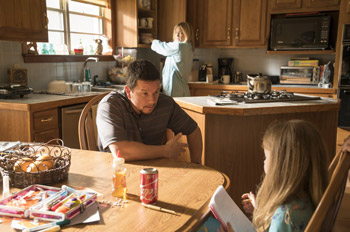 The production also built several water tanks for the oceanic action, with a main tank holding 2,094,400 gallons, taking three days to fill. Chris Seagers says of the painstakingly detailed collaboration with Peter Berg: 'Peter Berg's the kind of guy who knows what he wants and he had one directive: keep it true."
The production also built several water tanks for the oceanic action, with a main tank holding 2,094,400 gallons, taking three days to fill. Chris Seagers says of the painstakingly detailed collaboration with Peter Berg: 'Peter Berg's the kind of guy who knows what he wants and he had one directive: keep it true." That was an especially daunting mandate for the actual blowout sequence, which deluged the cast with surging seawater, fire and mud in Biblical proportions. Says special effects supervisor Burt Dalton: 'Getting the blowout sequence correct was an incredible process. We consulted with experts who were there on the day, but it took us a long time to find just the right equipment to re-create that moment."
The challenges of creating and working on these intricate sets brought cast and crew closer – but also were a constant reminder of just how much greater the difficulties were to those who found themselves trying to survive the most destructive oil rig disaster in history.
Sums up director of photography Enrique Chediak: 'There are many emotions people have about the Deepwater Horizon oil spill. This movie makes you aware of what the people on the rig had to go through – and that is the part that is so incredible."
Deepwater Horizon
Release Date: October 6th, 2016
Have You Seen This?
MORE
- Mission: Impossible Fallout
- Glenn Close The Wife
- Allison Chhorn Stanley's Mouth Interview
- Benicio Del Toro Sicario: Day of the Soldado
- Dame Judi Dench Tea With The Dames
- Sandra Bullock Ocean's 8
- Chris Pratt Jurassic World: Fallen Kingdom
- Claudia Sangiorgi Dalimore and Michelle Grace...
- Rachel McAdams Disobedience Interview
- Sebastián Lelio and Alessandro Nivola...
- Perri Cummings Trench Interview


